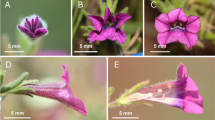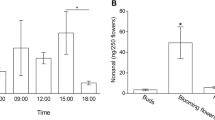Summary
The means by which newly emerged pollen-specific (oligolectic) solitary bees locate their appropriate pollen host plant is not clearly understood. To evaluate the role of flower and pollen odors in this recognition process, preference tests were performed on foraging-inexperienced and, for comparison, field-experienced individuals of the solitary bee Colletes fulgidus longiplumosus. The bees were presented with a choice of four plant species, offered in the form of aromas from flowers, whole pollen, pollenkitt, and internal pollen lipids. Observed feeding-attempt response patterns suggest: 1) that bees can distinguish between plant species on the basis of odors from flowers, whole pollen, and pollenkitt, 2) inexperienced bees show a preference for the pollen on which they were reared as larvae, and 3) chemicals eliciting feeding responses to pollen appear to be contained in the pollenkitt. Feeding responses by experienced bees differ from those of inexperienced bees in ways which indicate that the insects' odor-based search image of the host plant becomes modified by foraging experience.
Similar content being viewed by others
References
Aufsess A von (1960) Geruchliche Nahorientierung der Biene bei entomophilen und ornithophilen Blüten. Z Vergl Physiol 43:469–498
Bitterman ME, Menzel R, Fietz A, Schafer S (1983) Classical conditioning of proboscis extension in honeybees (Apis mellifera). J Comp Psychol 97:107–119
Boch R (1982) Relative attractiveness of different pollens to honeybees when foraging in a flight room and when fed in the hive. J Apic Res 21:104–106
Boelter AM, Wilson WT (1984) Attempts to condition the pollen preference of honey bees. Amer Bee J 124:609–610
Bolwig N (1954) The role of scent as a nectar guide for honeybees on flowers and an observation on the effect of colour on recruits. Br J Anim Behav 2:81–83
Cameron SA (1981) Chemical signals in bumble bee foraging. Behav Ecol Sociobiol 9:257–260
cane JH (1983) Olfactory evaluation of Andrena host nest suitability by kleptoparasitic Nomada bees. Anim Behav 31:138–144
Cazier MA, Linsley EG (1974) Foraging behavior of some bees and wasps at Kallstroemia grandiflora flowers in Southern Arizona and New Mexico. Amer Mus Nov No 2546
Corbet SA (1985) Insect chemosensory responses: a chemical legacy hypothesis. Ecol Entomol 10:143–153
Cruden RW (1972) Pollination biology of Nemophila menziesii (Hydrophyllaceae) with comments on the evolution of oligolectic bees. Evolution 26:373–389
Dobson HEM (1980) Interactions of bees and shrubs in the California chaparral community. MS Thesis, Univ Calif Davis, CA
Dobson HEM (1985) Pollen and pollen-coat lipids: chemical survey and role in pollen selection by solitary bees. PhD Dissertation, Univ Calif Berkeley, CA
Dobson HEM (in press) Survey of pollen and pollenkitt lipids: chemical cues to flower visitors? Amer J Bot
Dobson HEM (in press) Possible roles of pollenkitt in flower selection by bees: an overview. In: Buchmann SL (ed) Experimental Studies on Pollination and Pollinator Foraging Efficiency. Univ Arizona Press, Tucson
Dobson HEM, Bergström J, Bergström G, Groth I (in press) Comparison of pollen and flower volatiles in two Rosa species. Phytochemistry
Doull KM (1966) The relative attractiveness to pollen-collecting honeybees of some different pollens. J Apic Res 5:9–14
Doull KM, Standifer LN (1970) Feeding responses of honeybees in the hive. J Apic Res 9:129–132
Faegri K, van der Pijl L (1979) The principles of pollination ecology, 3rd ed. Pergamon Press, Oxford
Frankie GW, Vinson SB (1977) Scent marking of passion flowers in Texas by females of Xylocepa virginica texana (Anthophoridae). J Kansas Entomol Soc 50:613–625
Free JB (1963) The flower constancy of honeybees. J Anim Ecol 32:119–131
Free JB (1970a) The flower constancy of bumblebees. J Anim Ecol 39:395–402
Free JB (1970b) Insect pollination of crops. Academic Press, London
Free JB, Williams IH (1983) Scent-marking of flowers by honeybees. J Apic Res 22:86–90
Frisch K von (1923) Über die “Sprache” der Bienen. Zool Jahrb Abt Allg Zool Physiol 40:1–186
Gupta M, Kapil RP (1984) Olfactory response of workers of Apis florea F: to some repellents in semi-field conditions. In: Tasei JN (ed) Proc 5th Int Symp Pollination 1983, INRA, Paris, pp 65–78
Hohmann H (1970) Über die Wirkung von Pollenextrakten und Duftstoffen auf das Sammel- und Werbeverhalten Höselnder Bienen (Apis mellifica L.). Apidologie 1:157–178
Hopkins CY, Jevans AW, Boch R (1969) Occurrence of octadecatrans-2, cis-9, cis-12-trienoic acid in pollen attractive to the honey bee. Can J Biochem 47:433–436
Hügel M-F (1962) Étude de quelques constituents du pollen. Ann Abeille 5:97–133
Hurd PD, Linsley EG (1963) Pollination of the unicorn plant (Martyniaceae) by an oligolectic, corolla-cutting bee. J Kansas Entomol Soc 36:248–252
Hurd PD, LaBerge WE, Linsley EG (1980) Principal sunflower bees of North America with emphasis on the Southwestern United States. Smithson Contr Zool No 310
Klungness LM, Peng Y (1984) a histochemical study of pollen digestion in the alimentary canal of honeybees (Apis mellifera L.). J Insect Physiol 30:511–521
Knoll F (1930) Über Pollenkitt und Bestaubungsart. Z Bot 23:609–675
Koltermann R (1973) Rassen- bzw. artspezifische Duftbewertung bei der Honigbiene und ökologische Adaptation. J Comp Physiol 85:327–360
Kriston I (1973) Die Bewertung von Duft- und Farbsignalen als Orientierungshilfen an der Futterquelle durch Apis mellifera L. J Comp Physiol 84:77–94
Kugler H (1932) Blutenökologische Untersuchungen mit Hummeln. IV. Der Duft als chemischer Nahfaktor bei duftenden und “duftlosen” Blüten. Planta 16:534–553
Lepage M, Boch R (1968) Pollen lipids attractive to honeybees. Lipids 3:530–534
Levin MD, Bohart GE (1955) Selection of pollens by honey bees. Amer Bee J 95:392–393, 402
Lex T (1954) Duftmale an Blüten. Z Vergl Physiol 36:212–234
Linsley EG (1958) The ecology of solitary bees. Hilgardia 27:543–599
Linsley EG (1961) The role of flower specificity in the evolution of solitary bees. Proc 11th Int Congr Entomol 1960, Vienna, vol 1 pp 593–596
Linsley EG (1978) Temporal patterns of flower visitation by solitary bees, with particular reference to the southwestern United States. J Kansas Entomol Soc 51:531–546
Linsley EG, MacSwain JW, Raven PH (1963) Comparative behavior of bees and Onagraceae I. Oenothera bees of the Colorado Desert. Univ California Publ Entomol 33:1–24
Loper GM (1972) Factors affecting the quantity of alfalfa flower aroma and a subsequent influence on honey bee selection. Agron Abstr, pp 15
Loper GM, Berdel RL (1978) Seasonal emanation of ocimene from alfalfa flowers with three irrigation treatments. Crop Sci 18:447–452
Louvenaux J (1959) Recherches sur la récolte du pollen par les abeilles (Apis mellifica L.). Ann Abeille 2:13–111
Manning A (1957) Some evolutionary aspects of the flower constancy of bees. Proc R Phys Soc Edinb 25:67–71
O'Neal RJ, Waller GD (1984) On the pollen harvest by the honey bee (Apis mellifera L.) near Tucson, Arizona (1976–1981). Desert Plants 6:81–94, 99–109
Pijl L van der (1960) Ecological aspects of flower evolution I Phyletic evolution. Evolution 14:403–416
Ribbands CR (1955) The scent perception of the honeybee. Proc R Soc Lond 143:367–379
Robacker DC, Flottum PK, Sammataro D, Erickson EH (1983) Effects of climatic and edaphic factors on soybean flowers and on the subsequent attractiveness of the plants to honey bees. Field Crops Res 6:267–278
Schemske DW (1983) Limits to specialization and coevolution in plant-animal mutualisms. In: Nitecki MH (ed) Coevolution. Univ Chicago Press, Chicago, pp 67–109
Schmidt JO (1982) Pollen foraging preferences of honey bees. Southwestern Entomol 7:255–259
Stanley RG, Linskens HF (1974) Pollen. Springer Berlin Heidelberg, New York
Stephen WP, Bohart GE, Torchio PF (1969) The biology and external morphology of bees. Agric Expt Sta Oregon State Univ, Corvallis
Taber S (1963) Why bees collect pollen. Rep-Abstr 19th Int Beekeeping Congr, Prague 1963, pp 114
Thorp RW (1969) Systematics and ecology of bees of the subgenus Diandrena (Andrenidae). Univ California Publ Entomol 52:1–146
Waller GD, Loper GM, Martin JH (1984) The use of honey bees in production of hybrid cotton seed. In: Tasei JN (ed) Proc 5th Int Symp Pollination, 1983, INRA, Paris, pp 129–133
Williams NH (1983) Floral fragrances as cues in animal behavior. In: Jones EC, Little RJ (eds) Handbook of Experimental Pollination Biology. Van Nostrand Reinhold, New York, pp 50–72
Author information
Authors and Affiliations
Rights and permissions
About this article
Cite this article
Dobson, H.E.M. Role of flower and pollen aromas in host-plant recognition by solitary bees. Oecologia 72, 618–623 (1987). https://doi.org/10.1007/BF00378991
Received:
Issue Date:
DOI: https://doi.org/10.1007/BF00378991




